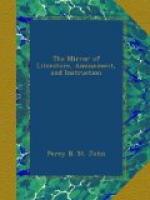That pretty sparkler of our summer evenings, so often made the ploughboy’s prize, the only brilliant that glitters in the rustic’s hat, the glowworm, (lampyris noctiluca,) is not found in such numbers with us, as in many other places, where these signal tapers glimmer upon every grassy bank; yet, in some seasons, we have a reasonable sprinkling of them. Every body probably knows, that the male glowworm is a winged, erratic animal, yet may not have seen him. He has ever been a scarce creature to me, meeting perhaps with one or two in a year; and, when found, always a subject of admiration. Most creatures have their eyes so placed, as to be enabled to see about them; or, as Hook says of the house-fly, to be “circumspect animals;” but this male glowworm has a contrivance, by which any upward or side vision is prevented. Viewed when at rest, no portion of his eyes is visible, but the head is margined with a horny band, or plate, being a character of one of the genera of the order coleoptera, under which the eyes are situate. This prevents all upward vision; and blinds, or winkers, are so fixed at the sides of his eyes, as greatly to impede the view of all lateral objects. See Figures. The chief end of this creature in his nightly peregrinations is to seek his mate, always beneath him on the earth; and hence this apparatus appears designed to facilitate his search, confining his view entirely to what is before or below him. The first serves to direct his flight, the other presents the object of his pursuit: and as we commonly, and with advantage, place our hand over the brow, to obstruct the rays of light falling from above, which enables us to see clearer an object on the ground, so must the projecting hood of this creature converge the visual rays to a point beneath.
Glowworms emit light only for a short period in the year; and I have but partially observed it after the middle of July. I have collected many of these pretty creatures on a bank before my house, into which they retire during the winter, to shine out again when revived by the summer’s warmth; but in this latter season I have frequently missed certain of my little proteges, and have reason to apprehend, that they formed the banquet of a toad, that frequented the same situation.
Observing above, that the glowworm does not emit light after the 14th of July, I mean thereby that clear, steady light, which has rendered this creature so remarkable to all persons; for I have repeatedly noticed, deep in the herbage, a faint evanescent light proceeding from these creatures, even as late as August and September. This was particularly manifested September the 28th, 1826. The evening was warm and dewy, and we observed on the house-bank multitudes of these small evanescent sparks in the grass. The light displayed was very different from that which they exhibit in warm summer months. Instead of the permanent green glow, that illumines all the blades of the surrounding herbage,




